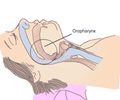- Shallow breathing - (http://en.wikipedia.org/wiki/shallow_breathing)
About
What is Rapid Shallow Breathing?
Rapid shallow breathing or tachypnea is a condition wherein a person takes rapid minimal breaths, usually with the assistance of the chest muscles. Shallow breathing is also called chest breathing or thoracic breathing. It could be a symptom of hyperventilation, lung infection, asthma, COPD, anxiety disorders, pulmonary edema, pneumonia or congestive heart failure.
Respiratory acidosis and reduced blood oxygenation may occur due to shallow breathing. People may experience tiredness, breathing difficulties, excessive daytime fatigue, daytime sleepiness (narcolepsy), weakness, drowsiness, insomnia (sleeplessness) and ultimately collapse due to inadequate breathing.
Severe degree of shallow breathing can cause disorientation, delirium, confusion, cyanosis (turning blue) and even seizures.
Causes of Rapid Shallow Breathing: Shallow, rapid breathing could be due to several causes including:
Asthma: Asthma is a condition where airways narrow, making it difficult to breathe. The shallow, rapid breathing is usually accompanied by a wheezing sound as the patient exhales.
Choking: Choking could be due to physical obstruction by foreign objects within the airways or by mechanical compression of the airways from outside. Choking can cause rapid, shallow breathing. In cases where the obstruction is complete, breathing stops and the person can die.
Pneumonia and other Lung Infections: Pneumonia is a bacterial or viral infection of the air sacs of the lungs. Pneumonia affects around close to 500 million people or 7% of global population annually Common symptoms of pneumonia include fever, cough, chest pain and breathing difficulties.
Bronchiolitis (in Children): Bronchiolitis in children is a common viral infection of lungs mostly caused by Respiratory Syncytial Virus (RSV). This causes inflammation and swelling in the tiny bronchioles, making it difficult for a child to breathe. Common symptoms include fever, running nose, heavy cough and wheezing. Other signs could include fast rapid breathing with a high-pitched wheezing sound, flaring of nostrils, increased irritability, crankiness, or tiredness, not eating properly or trouble with sleeping.
Transient Tachypnea in the Newborn: Transient tachypnea is a respiratory disease of newborns, characterized by rapid breathing, usually seen in babies shortly after delivery. Newborns with transient tachypnea have breathing problems soon after birth, usually within 1 - 2 hours. Most of such infants improve within 12 - 24 hours.
COPD and Chronic Lung Diseases: Chronic Obstructive Pulmonary Disease (COPD) is amongst the most common lung diseases. COPD could be due to chronic bronchitis, emphysema or both. Smoking is the common cause of COPD, while smoke due to firewood / charcoal cooking is the leading cause COPD in rural women.
Pulmonary Embolism: Pulmonary embolism is sudden blockage of the pulmonary artery by blood clot. Pulmonary embolism is a life threatening condition that may even cause death. The main cause of pulmonary embolism is deep vein thrombosis. It causes rapid, shallow breathing with sometimes bloody sputum.
Pulmonary Edema: Pulmonary edema is excess fluid accumulation in lungs making it difficult to breathe. Cardiovascular diseases including coronary artery disease, cardiomyopathy, heart failure and heart valve stenosis account for the most cases of pulmonary edema. Other non-cardiac causes include lung infections, chronic kidney disease, exposure to toxins or obnoxious substance, adverse drug reactions and near-drowning. The presence of fluid in the lungs can be demonstrated with an x-ray.
Apart from the above, stress, anxiety and panic attacks also cause rapid breathing and breathlessness.
Treatment of Rapid Shallow Breathing
Treatment for shallow breathing is individualized depending on the underlying cause, the presence of coexisting diseases, the age and medical history of the patient, and other factors.
If shallow breathing results in low levels of oxygen in the blood, supplemental oxygen is generally used; often such condition requires hospitalization.
When shallow breathing is caused by a viral infection, such as viral pneumonia, the treatment includes rest, increased fluids and using nebulizer.
When shallow breathing is caused by bacterial infection, as in bacterial pneumonia, antibiotics are often prescribed. Treatment for asthma may include corticosteroids and bronchodilators, which are breathed in via inhalers and nebulizers.
Other respiratory diseases or heart failure often necessitate additional intravenous medications, hospitalization, intensive care and possibly life support assistance.
Deep breathing exercises such as pranayam, yoga and deep stomach breathing exercises may relieve or minimize shallow breathing in some cases.









